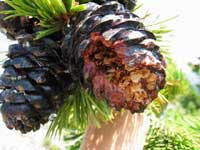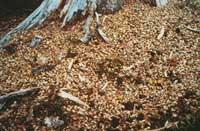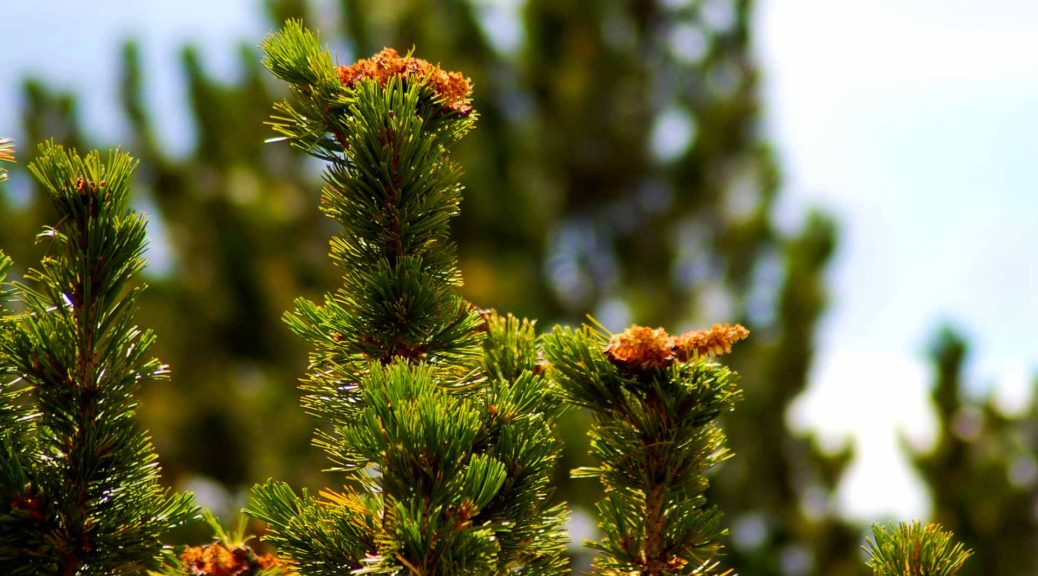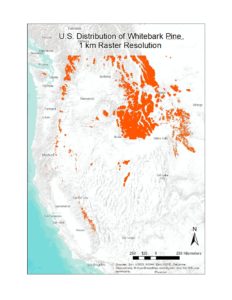[no_toc]
-Dana L. Perkins
Systematics
Whitebark pine is one of five species known worldwide as “stone pines” (Pinus albicaulis, P. cembra, P. sibirica, P. pumila, and P. koraieensis). They differ from all other pines in cone morphology. The cones of the stone pines are indehiscent, which means that the scales do not open when seeds are ripe, so the seeds are retained. The seeds are removed from cones by the three worldwide species of “nutcrackers” (genus Nucifraga) (Lanner 1982). The nutcracker-stone pine interactions are regarded as coevolved mutualisms, whereby the nutcrackers are the primary seed dispersers for the five stone pines (Tomback and Linhart ).
Pines are gymnosperms, classified in the class Pinopsida, order Pinales, and Division Coniferophyta (USDA, NRCS 2009). Whitebark pine is further classified in the subgenus Strobus, the “white” or “soft” pines technically referred to as haploxylon pines for having one rather than two fibrovascular bundles per needle. Traditionally, whitebark pine was placed in section Strobus and subsection Cembrae (Little and Critchfield 1969; Price and others 1998). Recent genetic studies have suggested that Cembrae pines do not form a geneticallydistinct (monophyletic) group (Gernandt et al, 2005). These authors recommended merging two five-needle white pine subsections — Strobi and Cembrae – to form a new subsection Strobus, within a new pine section Quinquefoliae.

Distribution
Whitebark pine, along with several other five-needle white pines (Pinus flexilis, Pinus longaeva, Pinus aristata, and Pinus balfouriana) occurs at the highest elevations of western tree species ( Arno and Hoff 1990, Tomback et al 2011). Whitebark pine has the largest and northern-most distribution of all five-needle white pines (Tomback and Achuff 2010). At its northernmost latitudes in British Columbia (55 deg. N), it occurs at elevations as low as 5,500 ft (1680 meters), and ranges to elevations over 10,000 feet (3050 m) in Wyoming (42 deg. N) and up to 12,000 ft (3,658 m) in California (36 deg. N). Whitebark pine occurs primarily in upper subalpine forests and at treeline in the United States and Canada, including the northern Rocky Mountains, Great Basin, Sierra Nevada and Cascades, and northern coastal ranges (Arno and Hoff 1990; McCaughey and Schmidt 2001) (Figure 1.2). Its distribution is split into two broad sections: western and eastern. The western coastal batholith and volcanic chain sections include the Sierra Nevada and Klamath Mountains of California and Cascade Mountains of California, Oregon, Washington, and British Columbia, and also the Olympic Mountains of Washington and coastal ranges through the Bulkley Mountains of British Columbia. The eastern Rocky Mountains sections range from the Wyoming and Wind River ranges of western Wyoming, north through the Greater Yellowstone Area, Idaho, Montana, and north to about 55º latitude in Alberta and British Columbia. Whitebark pine also grows in the Great Basin ranges of California, in western, northern and eastern Nevada, and in the Blue and Wallowa Mountains of northeastern Oregon, northeastern Washington, and southern British Columbia (Little and Critchfield 1969; Ogilvie 1990). Updated information for the range-wide distribution of whitebark pine, using a standard scale and minimum size polygon, is available on the Whitebark Pine Ecosystem Foundation website.

Description
Whitebark pine occurs on high elevation sites characterized by rocky, poorly developed soils, cold temperatures, and snowy, wind-swept exposures (Arno and Hoff 1989). Whitebark pine occurs in three distinct community types: 1) dominant and self-replacing over time in climax communities, which are open stands on harsh, wind-swept sites, 2) flagged and krummholz (mat-like growth) trees, growing either solitarily or in dense groups with other species (tree islands) in tree line communities, and 3) a minor to major seral species on productive sites with other conifers such as subalpine fir (Abies lasiocarpa), lodgepole pine (Pinus contorta), Douglas-fir (Pseudotsuga menziesii), Engelmann spruce (Picea engelmannii), limber pine (Pinus flexilis), and other conifers (Arno and Hoff 1989, Tomback et al 2001) (Fig. 1.3).
In climax communities, whitebark pine is a long-lived tree attaining ages of over 1,000 years on exposed sites. Mature trees over 400 years old are common (Luckman and others 1984, Perkins and Swetnam 1996). It is slow-growing, investing in extensive root systems, and rarely grows faster than other conifers except on the most severe sites (Arno and Hoff 1989). Whitebark pine is considered shade-intolerant to moderately shade-tolerant (Minore 1979, Arno and Hoff 1989) and a poor competitor, which accounts for its successional status. On productive sites, it reaches heights of 22 to 65 ft. (7 to 20 m). Clark’s nutcracker are the primary seed disperser for whitebark pine, and bury seeds several centimeters deep in soil or other substrate in caches of 1 to 15 seeds (Tomback 1978, Hutchins and Lanner 1982, Lorenz et al 2011). Seeds that are not retrieved from these seed caches may germinate in place, leading to seedling establishment. As a consequence of multiple seeds in a cache, whitebark pine frequently occurs as a “tree cluster,” which is a closely-associated group of genetically-distinct stems (Lanner 1980, Linhart and Tomback 1985, Furnier et al 1987). It also occurs as a single-stemmed form (Fig. 1.4). The krummholz form that occurs at the highest elevations is long-lived, and reproduces by layering (King and Graumlich 1998).
Whitebark pine seeds may be cached near source trees or more rarely transported 32 km or farther across the landscape (Lorenz and others 2011; Tomback 1978). Nutcrackers cache across a variety of terrain, primarily in their home areas ranging in size from 0.5 to 20 square miles (1.4 to 52 square kilometers). They use many forest types, including ponderosa pine (Pinus ponderosa), mixed conifer, and whitebark pine habitats. Seed caches are generally close to source trees (Lorenz et al 2011; Tomback 1978), but have also been reported in open areas (Norment 1991) and burned areas (Tomback et al 1993, 2001b). In contrast to resident nutcrackers with established home ranges, nutcrackers also occur as migrant populations, caching seeds in autumn and moving on to new locations (Lorenz et al 2011). Because whitebark pine seeds are primarily dispersed by Clark’s nutcracker, nutcracker behaviors and population dynamics are extremely important to whitebark pine conservation.
Whitebark pine is a monoecious species, with both male and female strobili located on the same tree (Arno and Hoff 1989). Female cones (strobili) are deep purple when immature, purple-brown when mature, elliptical in shape, and grow at the tips of branches, primarily in the upper crown (Fig. 1.5) (Arno and Hoff 1989). Male pollen cones are deep red when mature, fading to rust-brown when dry, and are generally found in the lower crown (Fig.1.5). Needles occur in fascicles of five, are 1.2-2.8 in. (3-7 cm) long, and a deep-yellow green to dark-green color. Unripe cones are resinous and range in length from 2 – 3.5 in. (5 to 8 cm); they are sessile, usually occur in clusters of two to five and remain on the tree unless dislodged by animals (Arno and Hoff 1989). Cones are ovoid, with scales that are thick distally and terminate in a blunt tip. Cones contain about 60 large, 0.28 -0.43 in. (7 – 11 mm) long, wingless seeds (Forcella and Weaver 1980; Owens and others 2008; Weaver and Fo
rcella 1986). Tomback (1982) in the eastern Sierra Nevada reported a mean of 45 filled seeds per cone, whereas Owens et al (2008) and Weaver and Forcella (1986) reported 66 and 75 seeds per cone respectively in the Rocky Mountains. Whitebark pine starts producing cones at 30 to 50 years of age, with sufficient canopy volume to have high cone production at about 125 to 250 years of age (Arno and Hoff 1989; Krugman and Jenkinson 1974). The frequency of synchronous abundant cone crop years, or masting events, varies regionally by climate and population level, from yearly to every 2-5 years in many areas, although a few cones are produced within a stand nearly every year (Arno and Hoff 1990; Crone and others 2011; Krugman and Jenkinson 1974; Tomback and others 2001b).
Other pages in this section
*** previous title *** --- *** next title ***



